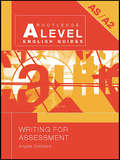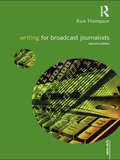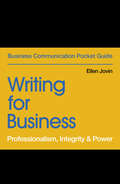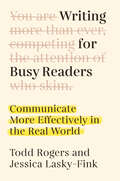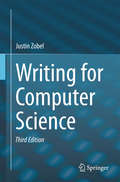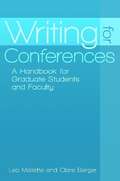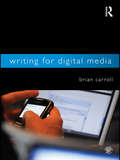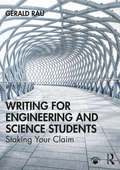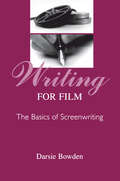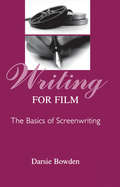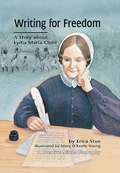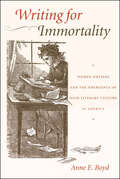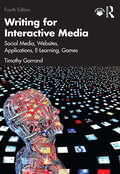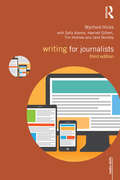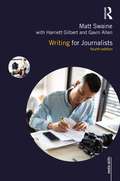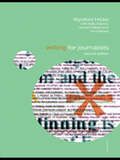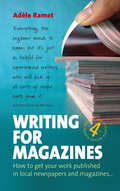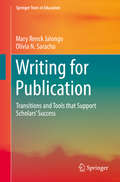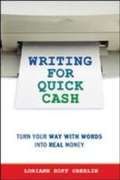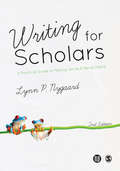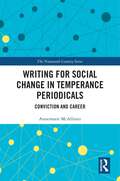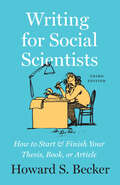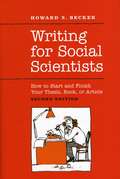- Table View
- List View
Writing for Assessment (Routledge A Level English Guides)
by Angela GoddardThis text helps students to develop the writing skills they need to succeed in AS and A2 level English; offers a step-by-step guide to approaching writing tasks and structuring a response; looks at a range of writing tasks, from argumentative essays to data-based investigations; provides Personal Audit Sheets (PASS) to help students assess their own writing skills and make practical steps to develop them; can be used as preparation for both coursework and exams.Written by an experienced teacher, author and AS and A2 level examiner, Writing for Assessment is an essential resource for all students of AS and A2 level English Language, English Literature, and English Language and Literature.
Writing for Broadcast Journalists (Media Skills)
by Rick Thompson'This is a superb book which combines the rare mixture of high quality information with humour. The style of writing engages the reader from the introduction and the experience and insight of the author occasionally makes it difficult to put down, a rare feature of a textbook. I would unreservedly recommend this book not only to those studying journalism but to students of language and all who use the spoken and written word as the ‘materials’ of their work.' Barry Turner, Nottingham Trent University 'Rick Thompson's guidance manual is packed with advice to would-be writers for this medium. He's someone with years of experience at the top level of the national and international profession, and he's smack up to date with his references. The book is aimed at journalists, but anyone with a serious interest in developing their literacy will learn a lot about professional writing skills from what he has to say.' Roy Johnson, www.mantex.co.uk Writing for Broadcast Journalists guides readers through the significant differences between the written and the spoken versions of journalistic English. It will help broadcast journalists at every stage of their careers to avoid such pitfalls as the use of newspaper-English, common linguistic errors, and Americanised phrases, and gives practical advice on accurate terminology and pronunciation, while encouraging writers to capture the immediacy of the spoken word in their scripts. Writing for Broadcast Journalists includes: practical tips on how to avoid ‘journalese’, clichés and jargon guidance on tailoring your writing style to suit a particular audience advice on converting agency copy into spoken English writing to television pictures examples of scripts from some of the best in the business an appendix of ‘dangerous’ words and phrases to be avoided in scripts.
Writing for Business: Professionalism, Integrity & Power
by Ellen JovinBuild essential skills and write with confidence at work! Immediately practical guide to better business writing designed to help you develop a clear, direct, natural communication style that supports rather than obscures what you want to say. Writing for Business covers writing principles that are relevant for a wide range of business documents, including email, letters, memos, reports, proposals, and more, while also offering editing tips to ensure you come across as professional and polished. The book features examples and tips straight from the workplace.
Writing for Business: Professionalism, Integrity & Power (Business Communication Pocket Guides)
by Ellen JovinBuild essential skills and write with confidence at work! Immediately practical guide to better business writing designed to help you develop a clear, direct, natural communication style that supports rather than obscures what you want to say. It covers writing principles relevant for a wide range of business documents, including email, letters, memos, reports, proposals, and more, while also offering editing tips to ensure you come across as professional and polished. Packed with examples and tips straight from the workplace.
Writing for Busy Readers: Communicate More Effectively in the Real World
by Todd Rogers Jessica Lasky-FinkWriting well is for school. Writing effectively is for life. Todd Rogers and Jessica Lasky-Fink offer the most valuable practical writing advice today. Building on their own research in behavioral science, they outline cognitive facts about how people actually read and distill them into six principles that will transform the power of your writing: Less is moreMake reading easyDesign for easy navigationUse enough formatting, but no moreTell readers why they should careMake responding easyIncluding many real-world examples, a checklist and other tools, this guide will make you a more successful and productive communicator. Rogers and Lasky-Fink bring Strunk and White&’s core ideas into the twenty-first century&’s attention marketplace. When the influential guides to writing prose were written, the internet hadn&’t been invented. Now, the average American adult is inundated with digital messages each day. With all this correspondence, capturing a busy reader&’s attention is more challenging than ever. This is how to do it.
Writing for Computer Science
by Justin ZobelAll researchers need to write or speak about their work, and to have research that is worth presenting. Based on the author's decades of experience as a researcher and advisor, this third edition provides detailed guidance on writing and presentations and a comprehensive introduction to research methods, the how-to of being a successful scientist. Topics include: · Development of ideas into research questions; · How to find, read, evaluate and referee other research; · Design and evaluation of experiments and appropriate use of statistics; · Ethics, the principles of science and examples of science gone wrong. Much of the book is a step-by-step guide to effective communication, with advice on: · Writing style and editing; · Figures, graphs and tables; · Mathematics and algorithms; · Literature reviews and referees' reports; · Structuring of arguments and results into papers and theses; · Writing of other professional documents; · Presentation of talks and posters. Written in an accessible style and including handy checklists and exercises, Writing for Computer Science is not only an introduction to the doing and describing of research, but is a valuable reference for working scientists in the computing and mathematical sciences.
Writing for Conferences: A Handbook for Graduate Students and Faculty
by Leo A. Mallette Clare BergerThe authors present a practical text for graduate students and faculty, as well as professionals working in areas outside academia--businesses, government entities, and nonprofit organizations--that encourage employees to publish at conferences. Organized into sections corresponding to the timeline of a conference paper, the text covers reasons for choosing to publish at conferences versus in journals or magazines, what it will cost, and publishing statistics; steps for selecting the right conference, including finding upcoming conferences, reading a call for papers, and the timeline for submitting a paper to a conference; deciding on solo authorship versus multiple authorship, finding co-authors, and the abstract submission process; writing a paper in a scholarly way; preparing for and giving the conference presentation; social interaction and networking at the conference; and how to be session chair. The material is illustrated throughout with case studies, examples, and vignettes from the literature and the authors' experiences.
Writing for Digital Media
by Brian CarrollWriting for Digital Media teaches students how to write effectively for online audiences--whether they are crafting a story for the website of a daily newspaper or a personal blog. The lessons and exercises in each chapter help students build a solid understanding of the ways that the Internet has introduced new opportunities for dynamic storytelling as digital media have blurred roles of media producer, consumer, publisher and reader. Using the tools and strategies discussed in this book, students are able to use their insights into new media audiences to produce better content for digital formats and environments. Fundamentally, this book is about good writing--clear, precise, accurate, filled with energy and voice, and aimed directly at an audience. Writing for Digital Media also addresses all of the graphical, multimedia, hypertextual and interactive elements that come into play when writing for digital platforms. Learning how to achieve balance and a careful, deliberate blend of these elements is the other primary goal of this text. Writing for Digital Media teaches students not only how to create content as writers, but also how to think critically as a site manager or content developer might about issues such as graphic design, site architecture, and editorial consistency. By teaching these new skill sets alongside writing fundamentals, this book transforms students from writers who are simply able to post their stories online into engaging multimedia, digital storytellers. For additional resources and exercises, visit the Companion Website for Writing for Digital Media at: www.routledge.com/textbooks/9780415992015.
Writing for Engineering and Science Students: Staking Your Claim
by Gerald RauWriting for Engineering and Science Students is a clear and practical guide for anyone undertaking either academic or technical writing. Drawing on the author’s extensive experience of teaching students from different fields and cultures, and designed to be accessible to both international students and native speakers of English, this book: Employs analyses of hundreds of articles from engineering and science journals to explore all the distinctive characteristics of a research paper, including organization, length and naming of sections, and location and purpose of citations and graphics; Guides the student through university-level writing and beyond, covering lab reports, research proposals, dissertations, poster presentations, industry reports, emails, and job applications; Explains what to consider before and after undertaking academic or technical writing, including focusing on differences between genres in goal, audience, and criteria for acceptance and rewriting; Features tasks, hints, and tips for teachers and students at the end of each chapter, as well as accompanying eResources offering additional exercises and answer keys. With metaphors and anecdotes from the author’s personal experience, as well as quotes from famous writers to make the text engaging and accessible, this book is essential reading for all students of science and engineering who are taking a course in writing or seeking a resource to aid their writing assignments.
Writing for Film: The Basics of Screenwriting
by Darsie BowdenIn this introduction to screenwriting, author Darsie Bowden provides sage, real-world advice and instruction on the process of writing film screenplays. This text will help budding screenwriters to structure their dramas, refine their characterizations, and craft their language, while also introducing them to the appropriate screenplay formats. It covers the complexities of writing for the screen and points out the contradictions to expect if readers pursue this work as a career. In addition to covering the elements of the dramatic film screenplay, Bowden discusses writing for such "alternative" markets as documentaries, independent films, experimental films, and other non-Hollywood options. Features of the text include:guidelines for working as a screenwriter;applications and exercises to enhance skills;suggested readings for further development; anda comprehensive list of resources for screenwriting.Successful writing for film lies in being able to heighten one's perceptive abilities about the world and to communicate those perceptions in a cinematic way. In this text, Bowden introduces readers to an approach to screenwriting that will help them see the world in a different way and write about it using different genres and media. This most valuable skill prepares readers for the range of possibilities they will encounter on the path to successful screenwriting.
Writing for Film: The Basics of Screenwriting
by Darsie BowdenIn this introduction to screenwriting, author Darsie Bowden provides sage, real-world advice and instruction on the process of writing film screenplays. This text will help budding screenwriters to structure their dramas, refine their characterizations, and craft their language, while also introducing them to the appropriate screenplay formats. It covers the complexities of writing for the screen and points out the contradictions to expect if readers pursue this work as a career. In addition to covering the elements of the dramatic film screenplay, Bowden discusses writing for such "alternative" markets as documentaries, independent films, experimental films, and other non-Hollywood options. Features of the text include:guidelines for working as a screenwriter;applications and exercises to enhance skills;suggested readings for further development; anda comprehensive list of resources for screenwriting.Successful writing for film lies in being able to heighten one's perceptive abilities about the world and to communicate those perceptions in a cinematic way. In this text, Bowden introduces readers to an approach to screenwriting that will help them see the world in a different way and write about it using different genres and media. This most valuable skill prepares readers for the range of possibilities they will encounter on the path to successful screenwriting.
Writing for Freedom: A Story about Lydia Maria Child
by Erica StuxA biography of the woman who risked her success in the male-dominated literary world of nineteenth-century America to become a passionate advocate for the abolition of slavery.
Writing for Immortality: Women and the Emergence of High Literary Culture in America
by Anne E. BoydBefore the Civil War, American writers such as Catharine Maria Sedgwick and Harriet Beecher Stowe had established authorship as a respectable profession for women. But though they had written some of the most popular and influential novels of the century, they accepted the taboo against female writers, regarding themselves as educators and businesswomen. During and after the Civil War, some women writers began to challenge this view, seeing themselves as artists writing for themselves and for posterity.Writing for Immortality studies the lives and works of four prominent members of the first generation of American women who strived for recognition as serious literary artists: Louisa May Alcott, Elizabeth Stuart Phelps, Elizabeth Stoddard, and Constance Fenimore Woolson. Combining literary criticism and cultural history, Anne E. Boyd examines how these authors negotiated the masculine connotation of "artist," imagining a space for themselves in the literary pantheon. Redrawing the boundaries between male and female literary spheres, and between American and British literary traditions, Boyd shows how these writers rejected the didacticism of the previous generation of women writers and instead drew their inspiration from the most prominent "literary" writers of their day: Emerson, James, Barrett Browning, and Eliot.Placing the works and experiences of Alcott, Phelps, Stoddard, and Woolson within contemporary discussions about "genius" and the "American artist," Boyd reaches a sobering conclusion. Although these women were encouraged by the democratic ideals implicit in such concepts, they were equally discouraged by lingering prejudices about their applicability to women.
Writing for Interactive Media: Social Media, Websites, Applications, e-Learning, Games
by Timothy GarrandThis thoroughly revised fourth edition teaches students and professionals how to create interactive content for all types of new media and become successful writers or designers in a variety of fields. This comprehensive guide is grounded in the core principles and skills of interactive media writing, in which writers create text and structure content to guide users through interactive products such as websites or software. The book examines case studies on interactive formats including complex informational websites, computer games, e-learning courses, training programs, and immersive exhibits. These case studies assess real-world products and documentation used by professional writers such as scripts, outlines, screenshots, and flowcharts. The book also provides practical advice on how to use interactive media writing skills to advance careers in the social media, technical, instructional communication, and creative media fields. This edition includes new chapters on UX Writing and Content Design, Social Media Writing, and Writing for Mobile. Writing for Interactive Media prepares students for the writing challenges of today’s technology and media. It can be used as a core textbook for courses in UX Writing, Writing for Digital Media, and Technical and Professional Communication and is a valuable resource for writing professionals at all levels. Supplemental resources include a sample syllabus, class assignments, student exercises, scripts, outlines, flowcharts, and other interactive writing samples. They are available online at www.routledge.com/9781032554242
Writing for Journalists (Media Skills)
by Tim Holmes Adams Sally Harriett Gilbert Wynford Hicks Jane BentleyThe new edition of Writing for Journalists focuses on the key issue for writers working across all forms of media today: how to produce clear, engaging and illuminating copy that will keep the reader hooked from start to finish. Written by skilled specialist contributors and drawing on a broad range of examples to illustrate the best professional practice, this edition includes: chapters on how to write news, features and reviews whatever the format used for delivery expanded chapters on writing for digital publication in both shortform and longform top tips on writing columns and blogs from leading professionals an exploration of the importance of style and its impact on great journalistic writing an extensive glossary of terms used in journalism and suggestions for further reading This is an essential guide to good writing for all practising journalists and students of journalism.
Writing for Journalists (Media Skills)
by Harriett Gilbert Matt Swaine Gavin AllenThoroughly revised and updated, the fourth edition of Writing for Journalists focuses on the craft of journalistic writing, offering invaluable insight on how to hook readers and keep them to the end of your article. The book offers a systematic approach to news and feature writing that starts with the basics and builds to more complex and longer pieces. The authors give the reader the tools they need to deliver engaging and authoritative writing that works across print and digital. Drawing on professional insight from writers across the industry, the book guides readers through the essential elements needed to write powerful and effective news stories, from hard news pieces to features on business, science, travel and entertainment reviews. New to this edition are hands-on writing exercises accompanying each chapter to help reinforce key points; chapters on how to build a professional profile, pitch stories and get commissioned; and a section on online writing, SEO, analytics and writing for social media. This is an essential guide for all journalism students and early-career journalists. It also has much to offer established journalists looking to develop their writing and lead editorial teams.
Writing for Journalists (Media Skills)
by Tim Holmes Sally Adams Harriett Gilbert Wynford HicksPraise for the first edition: 'There are books that are badly written, books that are well written and books that you wish you'd written. This is one of the latter. Hicks and his co-writers produce a book that is a joy to read and is packed full of helpful advice.' - Chris Frost, Journalist 'You don't have to be a journalist to read this book. Anyone with an interest in improving their writing skills and developing a sense of good style will find it useful Wynford Hicks takes a no-nonsense, sleeves rolled up approach to writing which has no time for preciousness.' - Roy Johnson, Mantex'Writing for Journalists neatly fills a gap in the market for a no-nonsense book for trainees written by trainers who genuinely understand the industry and who have moved with the times.' - Sharon Wheeler, Journalism Studies Writing for Journalists is about the craft of journalistic writing: how to put one word after another so that the reader gets the message - or the joke - goes on reading and comes back for more. It is a practical guide for all those who write for newspapers, periodicals and websites, whether students, trainees or professionals. This revised and updated edition introduces the reader to the essentials of good writing. Based on critical analysis of news stories, features and reviews from daily and weekly papers, consumer magazines, specialist trade journals and a variety of websites, Writing for Journalists includes: advice on how to start writing and how to improve and develop your style how to write a news story which is informative, concise and readable tips on feature writing from researching profiles to writing product round-ups how to structure and write reviews a new chapter on writing online copy.
Writing for Magazines: How to get your work published in local newspapers and magazines
by Adèle RametWritten by an experienced author, this practical book shows you how to produce manuscripts to fit a specific slot, advises you on how to adapt your style to suit different markets, and how to utilise research material to write facts and fiction effectively.Contents: 1. Mixing fact and fiction; 2. Constructing an article; 3. Getting articles into print; 4. Researching and filing systems; 5. Rewriting for different markets; 6. Writing short stories; 7. Caring for your characters; 8. Finding the right format; 9. Creating a Twist in the Tale; 10. Signposting; 11. Twisting With Little Old Ladies; 12. Fitting a Specific Plot; 13. Working as a Freelance; 14. Marketing Your Manuscript; 15. Keeping Records; Solutions to exercises; Glossary; Useful addresses; Further reading; Index.
Writing for Publication
by Mary Renck Jalongo Olivia N. SarachoThis book offers systematic instruction and evidence-based guidance to academic authors. It demystifies scholarly writing and helps build both confidence and skill in aspiring and experienced authors. The first part of the book focuses on the author's role, writing's risks and rewards, practical strategies for improving writing, and ethical issues. Part Two focuses on the most common writing tasks: conference proposals, practical articles, research articles, and books. Each chapter is replete with specific examples, templates to generate a first draft, and checklists or rubrics for self-evaluation. The final section of the book counsels graduate students and professors on selecting the most promising projects; generating multiple related, yet distinctive, publications from the same body of work; and using writing as a tool for professional development. Written by a team that represents outstanding teaching, award-winning writing, and extensive editorial experience, the book leads teacher/scholar/authors to replace the old "publish or perish" dictum with a different, growth-seeking orientation: publish and flourish.
Writing for Quick Cash: Turn Your Way with Words into Real Money
by Loriann Hoff Oberlin"Getting paid to write is every aspiring scribe's dream, but Writing for Quick Cash gives writers the tools and resources to make it reality. From researching potential clients to negotiating maximum pay rates, writers will learn every conceivable strategy for generating a steady flow of rewarding assignments that pay real money. Oberlin shows experienced and novice writers how to: * Survey opportunities in business and technical writing, online content, periodicals, book projects, greeting cards, newsletters, and much more * Market ideas and services to publishers, corporations, and others * Work with clients and editors smoothly and professionally * Create an efficient home office set-up for maximum productivity * Write like a journalist -- without taking journalism classes * Make the most of the latest and best writing software * Augment income through teaching, speaking, and editing jobs Filled with sage advice and savvy strategy, Writing for Quick Cash reveals a wealth of opportunities for full-timers and moonlighters alike. "
Writing for Scholars: A Practical Guide to Making Sense & Being Heard
by Lynn NygaardLecturers request your electronic inspection copy here. Academics are not just researchers, but writers too. Using her many years of practical experience gained as a teacher and editor, Lynn Nygaard guides you through the whole process of writing and presenting your research in order to help you make your voice heard within the academic community. Grounded in real world advice rather than abstract best practice, Nygaard demonstrates a number of approaches to writing in order to help you identify those most suited to your own project. This updated new edition includes: Revised and expanded sections in each chapter More focus on the social sciences A more international focus Updated discussions on publishing practices Annotated biographies for each chapter New illustrations and images Additional practical tips and exercises From defining your audience, to forming your argument and structuring your work, this book will enable you to communicate your research passionately and professionally. Lynn Nygaard is Special Adviser on Project Development and Publications at the Peace Research Institute Oslo (PRIO). Visit the companion website for additional online resources! SAGE Study Skills are essential study guides for students of all levels. From how to write great essays and succeeding at university, to writing your undergraduate dissertation and doing postgraduate research, SAGE Study Skills help you get the best from your time at university. Visit the SAGE Study Skills hub for tips, resources and videos on study success! This updated new edition includes: Revised and expanded sections in each chapter More focus on the social sciences A more international focus Updated discussions on publishing practices Annotated bibliographies for each chapter New illustrations and images Additional practical tips and exercises From defining your audience, to forming your argument and structuring your work, this book will enable you to communicate your research passionately and professionally.
Writing for Scholars: A Practical Guide to Making Sense & Being Heard
by Lynn NygaardAcademics are not just researchers, but writers too. Using her many years of practical experience gained as a teacher and editor, Lynn Nygaard guides you through the whole process of writing and presenting your research in order to help you make your voice heard within the academic community. Grounded in real world advice rather than abstract best practice, Nygaard demonstrates a number of approaches to writing in order to help you identify those most suited to your own project. This updated new edition includes: Revised and expanded sections in each chapter More focus on the social sciences A more international focus Updated discussions on publishing practices Annotated biographies for each chapter New illustrations and images Additional practical tips and exercises From defining your audience, to forming your argument and structuring your work, this book will enable you to communicate your research passionately and professionally. Lynn Nygaard is Special Adviser on Project Development and Publications at the Peace Research Institute Oslo (PRIO). Companion Website study.sagepub.com/nygaardwritingforscholars Visit the companion website for additional online resources! This updated new edition includes: Revised and expanded sections in each chapter More focus on the social sciences A more international focus Updated discussions on publishing practices Annotated bibliographies for each chapter New illustrations and images Additional practical tips and exercises From defining your audience, to forming your argument and structuring your work, this book will enable you to communicate your research passionately and professionally.
Writing for Social Change in Temperance Periodicals: Conviction and Career (The Nineteenth Century Series)
by Annemarie McAllisterThis book suggests alternative ways of looking at what made a writer, what people gained from writing, and explores the alternative world of temperance periodicals of the nineteenth and early twentieth century. It introduces some of the now-forgotten writers who, in their thousands, kept the Victorian periodical presses rolling, and the public entertained. Locating their writing in the context of their personal commitment, the study takes seven prolific writers who were outside what we now think of as the circuits of conventional publication and authorship, and looks at how they found ways to make their voices heard. Their absorption in a cause led them to forge impressive writing careers in a variety of genres and media, focusing around high-circulation temperance periodicals. Examining their cultural contributions as well as their professional lives confirms the importance of the temperance movement in the second half of the nineteenth century, and raises questions about distribution practices and values, and distinctions between ‘life’ and ‘work.’
Writing for Social Scientists: How to Start & Finish Your Thesis, Book, or Article (Chicago Guides to Writing, Editing, and Publishing)
by Howard S. BeckerThe classic guide to avoiding pitfalls and achieving success in academic writing—in a fully updated edition with a new preface by the author.For decades, Writing for Social Scientists has been a lifeboat for academic writers of all fields, from beginning students to seasoned professionals. With reassuring candor, author and sociologist Howard S. Becker identifies some of the common problems all academic writers face, including from procrastination and stifling perfectionism to getting caught up in the trappings of “proper” academic writing, and struggling with the when and how of citations. He then offers concrete advice, based on his own experiences and those of his students and colleagues, for overcoming these obstacles and gaining confidence as a writer.This new edition has been updated throughout to reflect the contemporary landscape of academic writing, offering a new generation of scholars and students encouragement to write about society or any other scholarly topic clearly and persuasively. As academics are called upon to write more often, in more formats, Writing for Social Scientists continues be an important resource for any writer’s shelf.
Writing for Social Scientists: How to Start and Finish Your Thesis, Book, or Article
by Howard Saul Becker Pamela RichardsStudents and researchers all write under pressure, and those pressures -- most lamentably, the desire to impress your audience rather than to communicate with them -- often lead to pretentious prose, academic posturing, and, not infrequently, writer's block. Sociologist Howard S. Becker has written the classic book on how to conquer these pressures and simply write. First published nearly twenty years ago, "Writing for Social Scientists" has become a lifesaver for writers in all fields, from beginning students to published authors. Becker's message is clear: in order to learn how to write, take a deep breath and then begin writing. Revise. Repeat. It is not always an easy process, as Becker wryly relates. Decades of teaching, researching, and writing have given him plenty of material, and Becker neatly exposes the foibles of academia and its "publish or perish" atmosphere. Wordiness, the passive voice, inserting a "the way in which" when a simple "how" will do -- all these mechanisms are a part of the social structure of academic writing. By shrugging off such impediments -- or at the very least, putting them aside for a few hours -- we can reform our work habits and start writing lucidly without worrying about grades, peer approval. In this new edition, Becker takes account of major changes in the computer tools available to writers today, and also substantially expands his analysis of how academic institutions create problems for them. As competition in academia grows increasingly heated, "Writing for Social Scientists" will provide solace to a new generation of frazzled, would-be writers.
